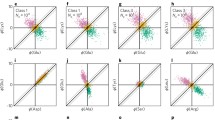Summary
The frequency of amino acid substitutions, relative to the frequency expected by chance, decreases linearly with the increase in physico-chemical differences between amino acid pairs involved in a substitution. This correlation does not apply to abnormal human hemoglobins. Since abnormal hemoglobins mostly reflect the process of mutation rather than selection, the correlation manifest during protein evolution between substitution frequency and physico-chemical difference in amino acids can be attributed to natural selection. Outside of ‘abnormal’ proteins, the correlation also does not apply to certain regions of proteins characterized by rapid rates of substitution. In these cases again, except for the largest physico-chemical differences between amino acid pairs, the substitution frequencies seem to be independent of the physico-chemical parameters. The limination of the substituents involving the largest physicochemical differences can once more be attributed to natural selection. For smaller physico-chemical differences, natural selection, if it is operating in the polypeptide regions, must be based on parameters other than those examined.
Similar content being viewed by others
References
Allison, A.C. (1954), British Medical Journal1, 290
Barker, W.C., McLanghlin, P.L., Dayhoff, M.O. (1972), Evolution of a complex system: The immunoglobulins, In: Atlas of protein sequence and structure, M.O. Dayhoff ed., pp. 31–40, Maryland: National Biomedical Research Foundation
Clarke, B. (1970), Nature (Lond.),228, 159–160
Dayhoff, M.O., Eck, R.V., Park, C.M., (1972a), A model of evolutionary change in proteins, In: Atlas of protein sequence and structure, M.O. Dayhoff ed., pp. 89–100, Maryland: National Biomedical Research Foundation
Dayhoff, M.O., Park, C.M., McLaughlin, P.J., (1972b), Building a phylogenetic tree: Cytochrome c., In: Atlas of protein sequence and structure, M.O. Dayhoff ed., pp. 7–16, Maryland: National Biomedical Research Foundation
Dayhoff, M.O. Hunt, L.T., McLaughlin, P.J., Jones, D.D. (1972c). Gene duplication in evolution: The globin. In: Atlas of protein sequence and structure. M.O. Dayhoff ed., pp. 17–30. Maryland: National Biomedical Research Foundation.
Dayhoff, M.O., Hunt, L.T., McLaughlin, P.J., Barker, W.C. (1972d). Data section. In: Atlas of protein sequence and structure. M.O. Dayhoff ed., pp. D-87–D-98. pp. D-173–D-228. Maryland: National Biomedical Research Foundation
Epstein, C.J. (1967). Nature (Lond.)215, 335–359
Fitch, W.H. (1966). J. Mol. Biol.10, 9–16
Fitch, W.H. (1967). J. Mol. Biol.26, 499–507
Fitch, W.M., Markowitz, E. (1970). Biochemical Genetics4, 579–593
Goodman, M., Moore, G.W. (1977). J. Mol. Evol.10, 7–47
Grantham, R. (1974). Science185, 862–864
Hasegawa, M., Yano, T. (1975). Viva Origino4, 11–18 (in Japanese)
Hayashi, A. (1975). Abnormal hemoglobin. In: Gendai Seibutu Kagaku, Vol. 16, Taisha Izyo, U. Yamamura ed., pp. 1–41 (in Japanese), Tokyo: Iwanami publishing company
International Hemoglobin Information Center (1976). R.N. Wtightstone, director, Medical College of Georgia
Kimura, M., Ohta, T. (1974). Proc. Nat. Acad. Sci. USA71, 2848–2852
Lehmann, H., Huntsman, R.G. (1974). Unstable haemoglobins and haemoglobins with altered oxygen affinity. In: Man's Haemoglobins. pp. 217–235, Amsterdam, Oxford: North-Holland publishing company
McLachlan, A.D. (1971). J. Mol. Biol.61, 409–417
Padlan, E.A. (1977). Quant. Rev. Biophys.10, 35–65
Padlan, E.A., Davies, D.R. (1975). Proc. Nat. Acad. Sci. USA72, 819–823
Perutz, M.F., Lehmann, H. (1968). Nature219, 902–909
Poljak, R.J., Amzel, L.M., Phizackerley, R.P. (1976). Prog. Biophys. Molec. Biol.31, 67–93
Romero-Herrera, A.E., Lehmann, H., Joysey, K.A., Friday, A.E. (1973). Nature246, 389–395
Sneath, P.H.A. (1966). J. Theor. Biol.12, 157–195
Vogel, F., Kopun, F. (1977). J. Mol. Evol.9, 159–180
Vogel, F. (1972). J. Mol. Evol.1, 334–367
Vogel. F., Rohrborn, G. (1966). Nature210, 116–117
Zuckerkandl, E. (1975). J. Mol. Evol.7, 1–57
Zuckerkandl, E., Pauling, L. (1965). Evolutionary divergence and convergence in proteins. In: Evolving genes and proteins. V. Bryson and H.J. Vogel eds., pp. 97–116, New York: Academic Press
Author information
Authors and Affiliations
Rights and permissions
About this article
Cite this article
Miyata, T., Miyazawa, S. & Yasunaga, T. Two types of amino acid substitutions in protein evolution. J Mol Evol 12, 219–236 (1979). https://doi.org/10.1007/BF01732340
Received:
Revised:
Issue Date:
DOI: https://doi.org/10.1007/BF01732340




